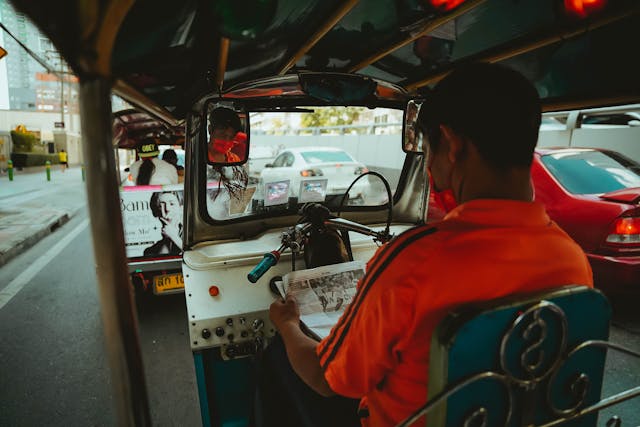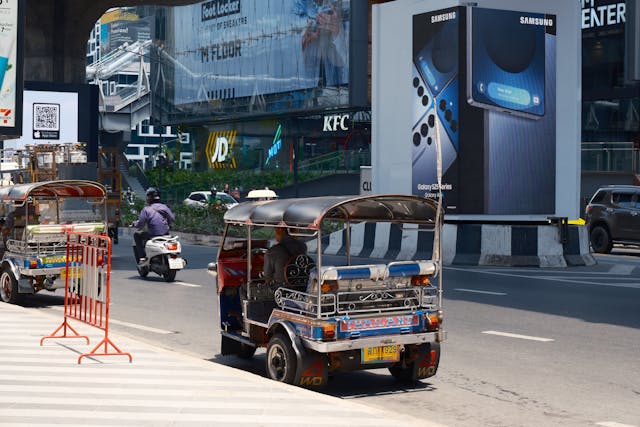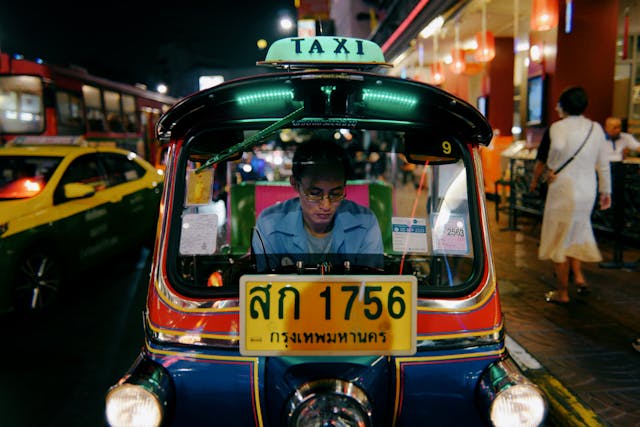Tuk tuks in Thailand are far more than a means of transportation — they’re a cultural staple and a thrilling part of the urban landscape. Painted in bold colors and often trimmed with lights or garlands, these iconic vehicles buzz through narrow streets, adding energy to the pulse of Thai cities. If you’ve never hopped into one, a Thailand tuk tuk ride might become your most memorable travel moment.
What Are Tuk Tuks in Thailand?

Compact and nimble, tuk-tuks are three-wheeled motorized vehicles built for maneuvering through dense city traffic. With no meters and a signature engine rumble, they’re the perfect mix of function and folklore. Tuk tuks in Thailand offer more than transport — they deliver a sensory experience on wheels.
Used by Locals Too
Many assume tuk-tuks cater only to tourists, but that’s far from true. Locals rely on them for short-distance errands, delivering goods, or even school runs in tight neighborhoods.
How Many People Fit?
Most tuk-tuks fit two to three passengers comfortably. In some provinces, you’ll see extended versions with roomier seating for extra legs or bags.
A Quick History of the Thai Tuk-Tuk
Thailand’s tuk-tuks evolved from post-war Japanese rickshaws brought over in the 1960s. Their lightweight build and agility helped them thrive in Bangkok’s increasingly clogged roads. Learn more about their origin on Wikipedia.
Where Tuk-Tuks Are Common in Thailand

Tuk-tuks are widespread across Thailand, especially near vibrant tourism hubs. In Bangkok, they tend to operate near hotspots like Khao San Road, the Grand Palace, Chinatown, and upscale malls like Siam Paragon. In Chiang Mai, the Old City and night markets are prime locations. Cities like Ayutthaya or Sukhothai also maintain their own fleets.
Different Styles by Region
Depending on the region, tuk-tuks can vary in shape and size. Some models in Phuket or Ayutthaya have taller roofs and wider seating — perfect for travelers with bulky luggage or groups.
How to Flag One Down
Just wave your hand with your palm facing downward as a tuk-tuk approaches. There’s no light system like taxis — it’s all about the gesture. A honk or nod from the driver usually signals availability.
How Much Do Tuk-Tuks Cost?
Average Fares
In Bangkok, prices range from 80 to 150 baht for short trips. Wondering about tuk tuk prices in Bangkok? Rates depend on location, traffic, and your negotiation skills. Chiang Mai tends to be cheaper overall.
Cash is standard, though more drivers now accept QR code payments via local Thai banking apps.
What Affects the Fare?
- Ride length
- Time of day
- Tourist vs. local areas
- Your ability to negotiate
Short Rides Work Best
Tuk-tuks shine on short trips. For anything longer or outside the city core, it’s smarter to grab a taxi or use a ride-hailing app like Grab.
When’s the Best Time?
During heavy rain, avoid tuk-tuks — their open design won’t protect you. Also skip the peak traffic hours (7–9 AM and 5–7 PM). Late evenings and early mornings offer a smoother, breezier experience.
How to Take a Tuk-Tuk in Thailand
First time in a tuk-tuk? No worries. Just flag one, smile, agree on the price, and climb in. If you’re in a popular district, they’ll probably find you first!
How to Negotiate the Fare Like a Local
Smart Tips
- Ask your hotel for the usual price beforehand
- Offer your number first, confidently and politely
- It’s okay to decline and try the next tuk-tuk
What to Expect
Drivers often quote high prices to tourists — it’s part of the game. A smile and some local knowledge can easily knock 20–30% off the initial price.
Useful Thai Phrase
If your driver zooms off like it’s a race, just say “cháa cháa noï” (ช้า ๆ หน่อย) — meaning “a little slower, please.” It works wonders.
How to Communicate
Many drivers speak basic English. Still, showing your destination on Google Maps or having it written in Thai is the safest bet. Visual aids go a long way!
Common Tuk Tuk Scams in Thailand
Watch out for “too good to be true” offers — like a 20 baht city tour. These are often ploys to shuttle you to shops where the driver earns a commission. Such tuk tuk scams Thailand are frequent near major temples. For a full list of tourist traps and how to avoid them, check out our complete guide on Thailand scams in 2025. Stick to your plan and verify any closures with Google or your hotel.
Some drivers may also take you to stores selling overpriced souvenirs or gems. Before buying anything, check our full guide on shopping in Thailand to avoid tourist traps and make smarter purchases.
Fun & Unique Tuk-Tuk Rides

Looking for a one-of-a-kind night out? Book a themed tuk-tuk tour! Whether it’s street food tastings, hidden temples, or bustling night markets, there’s a ride for every type of traveler. Tuk tuks in Thailand are more than a commute — they’re part of the adventure.
Eco-Friendly & Electric Options
Electric Tuk-Tuks Are Here
Electric tuk tuk Bangkok rides are the future — and they’re already operating in selected districts. These greener, quieter versions are great for the environment and easy to book.
Use the MuvMi App
Apps like MuvMi allow you to book electric tuk-tuks with live tracking and fixed fares in Bangkok. A great option for tech-savvy travelers seeking comfort and sustainability.
Comfort, Safety & Accessibility
- No seatbelts
- Open sides — keep your belongings close
- Cramped for tall passengers
- Can be too rough for very young kids or elderly travelers
Accessible Travel Tips
Standard tuk-tuks aren’t wheelchair accessible and rarely fit strollers. For families or those with mobility issues, Grab or metered taxis are the safer, more comfortable choice.
Tuk Tuk vs Taxi in Thailand
It’s the age-old question: tuk tuk vs taxi Thailand. Tuk-tuks are iconic, breezy, and great for a thrill. Taxis are air-conditioned, calm, and better for long trips. Choose the ride that suits your vibe.
Tuk-Tuks Compared to Other Thai Transport
| Transport | Price | Comfort | Flexibility | Safety | Best For | Pros | Cons |
|---|---|---|---|---|---|---|---|
| Tuk-Tuk | 80–150 baht | Basic | High | Open-sided | Short urban rides | Fun, authentic | Noisy, exposed |
| Taxi | 50–100 baht | Comfortable | Medium | Enclosed, safer | Families, long rides | Metered, air-con | Traffic, refusals |
| Grab | 60–120 baht | Very high | High | Reliable | Tech users | No cash, predictable | Requires app |
| Songthaew | 10–20 baht | Low | Limited | Basic safety | Budget travelers | Ultra cheap | Fixed route |
Go for the tuk-tuk if you want charm and chaos. Pick Grab or a taxi for AC and comfort. Use a songthaew if you’re counting every baht. For the ultimate freedom to explore off-the-beaten-path temples, beaches, or markets, consider renting a scooter in Thailand. It’s affordable, practical, and ideal for adventurous travelers—just make sure you meet the license and insurance requirements.
Explore our article on how weather affects transport in Thailand for more tips.
The Sensory Side of a Tuk-Tuk Ride
A tuk-tuk ride isn’t just about getting from A to B — it’s an assault on the senses. The engine rattles beneath your feet with a familiar “tuk-tuk-tuk” rhythm as neon signs flicker past. You might catch a whiff of sizzling street food, incense from a nearby shrine, or fresh rain on warm pavement. Honks, voices, and laughter blend into a chaotic symphony that’s uniquely Thai. It’s not polished — but it’s real, raw, and unforgettable.
📌 At a Glance: Tuk-Tuk Tips
- Best for: Short urban rides and local experiences
- Average fare: 80–150 baht (negotiate beforehand)
- Payment: Cash preferred, some accept Thai QR
- Watch out: Avoid detours to shops (common scam)
- When to ride: Avoid rain and rush hour traffic
- Bonus tip: Say “cháa cháa noï” (ช้า ๆ หน่อย) to go slower!
Conclusion
Whether it’s your first ride or your tenth, tuk tuks in Thailand always promise a bit of noise, a touch of charm, and a lot of local flavor. Know the tricks, ride smart, and enjoy the journey — your Thai adventure starts here.
🔄 Last updated on May 17, 2025
